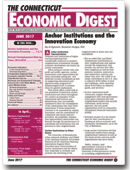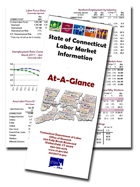Redevelopment for Workforce Housing
By Al Sylvestre Alan.Sylvestre@ct.gov, Research Analyst, Department of Labor
 he vision of Connecticut as a prosperous, inviting, and invigorating place to live, work, and play is brought to life by plans, places, and the networks that connect them. The most recent annual gathering of southern New England’s land use planners, economic development professionals, and scholars featured ideas, plans, and projects of great place making. Place making is fundamental to bringing growth and prosperity that business, government, and education leaders speak about when they talk of making Connecticut competitive with its neighbors.
he vision of Connecticut as a prosperous, inviting, and invigorating place to live, work, and play is brought to life by plans, places, and the networks that connect them. The most recent annual gathering of southern New England’s land use planners, economic development professionals, and scholars featured ideas, plans, and projects of great place making. Place making is fundamental to bringing growth and prosperity that business, government, and education leaders speak about when they talk of making Connecticut competitive with its neighbors.
While the majority of Connecticut households live in single family homes, multifamily developments of two or more units have become important to the housing market. Not only does multiple-unit housing use land more efficiently by enabling developers to spread construction costs among many units, it promotes greater affordability for households that earn the area median income or less. In the generation from 1998 to 2018, the share of authorized building permits for multifamily housing has more than doubled from 23% to 47%. This increase is partly the result of growing transit-oriented development (TOD) creating walkable urban environments that people seeking places to live find increasingly attractive.
Housing that is affordable to workers earning wages around their area’s median is essential to attracting and keeping a robust workforce. To this end, the US Department of Housing and Urban Development (HUD) established criteria to encourage affordable housing development. The criterion with which this article concerns itself has to do with area median income (AMI). New Haven County’s (annual) AMI ranges from $38,628 for a single-person household to $140,191 for a family with three or more income earners. For the entire state of Connecticut, those figures are $41,775 and $138,667. In the city of Meriden, where affordable housing is being developed as described below, its AMI are $45,777 and $135,000. Housing affordability for public benefits such as housing assistance programs (HAP) or affordability criteria such as those set forth in Connecticut General Statutes §8-30 (g) use percentages of AMI—30% for very low income earners; 80% for moderate income earners—to determine eligibility. Housing is generally affordable if the mortgage or rent consumes 28% or less of gross household income.
New Haven County’s (annual) AMI ranges from $38,628 for a single-person household to $140,191 for a family with three or more income earners. For the entire state of Connecticut, those figures are $41,775 and $138,667. In the city of Meriden, where affordable housing is being developed as described below, its AMI are $45,777 and $135,000. Housing affordability for public benefits such as housing assistance programs (HAP) or affordability criteria such as those set forth in Connecticut General Statutes §8-30 (g) use percentages of AMI—30% for very low income earners; 80% for moderate income earners—to determine eligibility. Housing is generally affordable if the mortgage or rent consumes 28% or less of gross household income.
Brownfields  redevelopment has great potential for workforce housing development. Because of its complexity and cost, brownfield remediation involves risk management techniques in addition to public subsidy as it is an iterative process of reclamation. The US Environmental Protection Agency developed a handbook for municipalities called PREPARED (Process for Risk Evaluation, Property Analysis, and Reuse Decisions) employing a multi-step process to:
redevelopment has great potential for workforce housing development. Because of its complexity and cost, brownfield remediation involves risk management techniques in addition to public subsidy as it is an iterative process of reclamation. The US Environmental Protection Agency developed a handbook for municipalities called PREPARED (Process for Risk Evaluation, Property Analysis, and Reuse Decisions) employing a multi-step process to:
- Identify, clarify, and gain support for brownfield reuse goals
- Identify and assess options for a particular brownfield property
- Evaluate the risks of involvement, and
- Formulate risk-minimizing strategies.
What began as a 54-acre brownfield with deserted buildings—including a former hospital and one-time newspaper office with its printing press—in downtown Meriden is becoming housing, retail, and commercial spaces a short walk from a new transit center. Using the PREPARED method with a form-based (zoning) code , Meriden is engaging with developers to create a vibrant, walkable, welcoming downtown that takes advantage of its proximity to public transportation, while preserving its housing affordability.
, Meriden is engaging with developers to create a vibrant, walkable, welcoming downtown that takes advantage of its proximity to public transportation, while preserving its housing affordability.
In addition to the transit station serving the Hartford Line commuter rail and the Amtrak long-distance passenger railroad, these projects are in design, under construction, or filling up with tenants:
- An 81-unit mixed-use development with apartments facing the Meriden Green (Figure 1) will occupy the Meriden Record Journal site with row houses along South Colony and Crown Streets;
- Apartments and retail spaces at Meriden Commons are available for lease with construction of its second phase underway. The $777 to $1,600 monthly rents on these apartments make them affordable to households earning between 67.8% of a single-person household AMI and 75.3% of AMI for a family of four
 ;
; - Completed in July 2018, 161 State Street with its fully-leased 75 units is built to energy-saving standards that incorporate heated air recirculation in a tight building envelope for significantly reduced energy costs. The second phase at 177 State Street (Figure 2), will include 76 apartments in three buildings with two townhouse-style buildings of four-bedroom units;
Affordable housing that blends in with established communities becomes possible with thoughtfully crafted land-use regulation embraced by the public. Northampton’s regulatory foundation includes zoning for infill  housing that eliminates frontage (lot width) requirements and reduces setbacks (distance of a use from its property boundaries). An essential element of neighborhood desirability is zoning for walkability that incorporates:
housing that eliminates frontage (lot width) requirements and reduces setbacks (distance of a use from its property boundaries). An essential element of neighborhood desirability is zoning for walkability that incorporates:
- Permissive lot dimensions;
- Multi-family housing;
- Mixed uses;
- No minimum-parking requirements;.
Northampton has begun to see results as it established five units of affordable housing through a small-lots competition that attracted designers that built homes developed by the city. The competition created excitement among the public while encouraging new design ideas. Using its HUD community development block grant, MassWorks and MassDOT Complete Streets funds, and tax increment financing , Northampton invests in parks, streetscapes, and infrastructure that enhances the allure of mixed-income housing in cluster development composed of small building lots with common open space.
, Northampton invests in parks, streetscapes, and infrastructure that enhances the allure of mixed-income housing in cluster development composed of small building lots with common open space.
Northampton also benefits from passive recreation, permanently preserved open space, bicycle links, and energy efficient units, while engaging its residents in a city-wide design discussion. With only five units added to the city’s housing stock, it is too soon to evaluate the effect North Hampton’s new approach to affordable housing is having on the city.
Transit oriented development and affordable housing are frequently discussed in presentations at the annual planners’ conference cited above. Those discussions address the shortage of workforce housing, the challenge of which can be met in cities, suburbs, and rural small towns. Lots available for infill development, buildings available for redevelopment, proximity to employment centers, and transportation infrastructure for expanded public transit, including the CT Fastrak bus-only roadway and CT Rail’s Hartford Line commuter railway, ensure that workforce housing has the opportunity to flourish. Public officials and land developers need to work together in adopting creative solutions to ameliorate high construction costs such as those tried and tested in Meriden and Northampton. Vexing issues, including the high land costs and the proliferation of auto-dependent places planned and built following the end of the World War II, must be resolved for Connecticut’s commitment to attracting and keeping members of the millennial generation to bear fruit.
 AMI estimates are supplied by the US Census Bureau’s American Community Survey. The numbers are annual averages based on 5-year (2013-2017) ACS calculations.
AMI estimates are supplied by the US Census Bureau’s American Community Survey. The numbers are annual averages based on 5-year (2013-2017) ACS calculations.
 A brownfield is defined by Connecticut General Statutes §32-760 as any abandoned or underutilized site where redevelopment, reuse or expansion has not occurred due to the presence or potential presence of pollution in the buildings, soil or groundwater that requires investigation or remediation before or in conjunction with the restoration, redevelopment, reuse and expansion of the property.
A brownfield is defined by Connecticut General Statutes §32-760 as any abandoned or underutilized site where redevelopment, reuse or expansion has not occurred due to the presence or potential presence of pollution in the buildings, soil or groundwater that requires investigation or remediation before or in conjunction with the restoration, redevelopment, reuse and expansion of the property.
 Form-based code, as an alternative to conventional zoning regulation, fosters predictable built results by using physical form rather than separation of uses as the organizing principle.
Form-based code, as an alternative to conventional zoning regulation, fosters predictable built results by using physical form rather than separation of uses as the organizing principle.
 Using the formula: [(monthly rent X 12) / 0.3] / AMI X 100. Since HUD requires a HAP renter to pay 30% of income toward rent, the preceding formula uses that ratio.
Using the formula: [(monthly rent X 12) / 0.3] / AMI X 100. Since HUD requires a HAP renter to pay 30% of income toward rent, the preceding formula uses that ratio.
 Infill refers to the development of vacant parcels within previously built areas that are already served by public infrastructure such as transportation, water, wastewater processing, and other utilities.
Infill refers to the development of vacant parcels within previously built areas that are already served by public infrastructure such as transportation, water, wastewater processing, and other utilities.
 TIF creates funding for public or private projects by borrowing against the future increase in these property-tax revenues.
TIF creates funding for public or private projects by borrowing against the future increase in these property-tax revenues.
 |



























